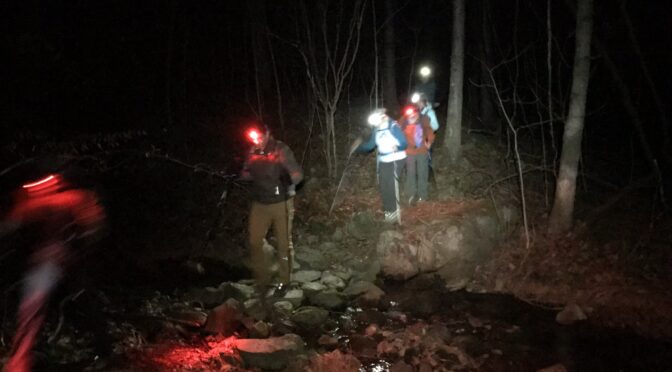We typically wait until the end of Daylight Saving Time to advocate hiking at night, for strapping on a headlamp and venturing down your favorite trails after dark. We’ve long been fans of hiking in night in winter because, for those of us in the workforce, it’s typically the only time we can work in a midweek hike. The sun sets at 5 p.m., before the whistle blows at the Widget Works, who cares? You’ve got a 300-lumen torch strapped to your forehead to light the way.
In 2020, we make an exception to our wait-until-Standard-Time rule. Two reasons.
- Crowded trails are returning. Remember how jammed the trails were when that perfect storm of pandemic and gorgeous spring weather combined in March, and April, and May? Expect more of the same, with color thrown into the mix. That first 70-degree weekend of fall? Look for the gates to some of our favorite state parks to start closing by 10 a.m.
- Glory in the gloaming. Late afternoon into evening into dark is simply a gorgeous time to be out. Consider: today, the sun sets at 7:39 p.m., with twilight extending until 8:05 p.m. Plenty of light for a 3-mile hike if you start by 6:30 p.m. At the end of September, the sun sets at 6:58 p.m., meaning you can still start in daylight, but you’ll be hiking into twilight, into the bewitching time when day gives way to night. By the end of October, that 6:30 hike will be starting shortly after sunset. With evening hikes, you’ll enjoy the trail in a whole different light (yes, literally), minus the masses. You’ll also get to experience that fall chill you’ve been waiting for.
A little leery of hiking in the dark? Here are some tips for making your night hike safe and enjoyable.
Tips for hiking at night
While we’d love for you to join us on our Tuesday Night Hikes, we know some of you would prefer to give it a go on your own. A few things to keep in mind:
- Get a headlamp. This is a must. Flashlights, work, sure, but you really want to keep your hands free. You can get a decent torch for as little as $20; note that LEDs cast a more hike-friendly light. Be sure to pack both extra batteries and a spare light (a little pen light will do) so you can see to change out your batteries.
- Pick short hikes to start. Night hiking takes some getting used to. Your world is confined to the glow of your headlamp, and it takes some concentration to focus on such a limited portion of the trail. Surprisingly, it can be a sensory overload, as your other senses tune in to the world beyond the scope of your light. Don’t overstay your first outing.
- Hike trails you’ve hiked in daylight. Even though it’s dark, familiarity is a big plus. You’ll be amazed at how things you didn’t think you noticed during the day will pop out as key markers of where you are on the trail.
- Hike by your feet. It takes a bit more effort to scout out the blazes at night rather than in the day. The best way to tell whether you’ve wandered off the beaten path is if your boots are suddenly sinking into soft, untrodden leaf litter. Backtrack and seek out firm footing.
- Bundle up. Nights are cooler than days; counter the chill with one more layer than you think you’ll need. You can always shed a layer down the trail.
- Don’t hike alone. I do a lot of soloing, but not at night.
- Again, take extra batteries. If your light goes out, you’re really in the dark.
- Again, take a backup light. Even a $5 keychain light can be a lifesaver if your main goes out. (Ever try to change batteries in the dark?)
- Take a map and compass. You should already have these in your daypack, but make extra sure you have them at night.
- Take water and snacks. Just because it’s dark doesn’t mean you can’t get dehydrated. And hiking in the cool air while concentrating on the trail will burn some calories; you’ll be glad to have the extra fuel.
- Appreciate the night sky. Because that’s one reason you’re hiking at night!
- Take a cell phone, just in case. Besides, most phones have a flashlight function that could save you in a pinch.
Note that most trails on public lands are closed from dusk until dawn. That includes state parks and nearly all municipal and county trails. National forests typically don’t have hours, nor do lands managed by the N.C. Wildlife Resources Commission.
Enjoy!
* * *
Night hike with us
You can hike on your own at night, or you can night hike with us! This year, we’re starting our Tuesday Night Hikes series in the fall, with nine hikes at nine locations in the Triangle. We start at 6:30 p.m., hike until about 8. Each hike is around 3 miles. Our night hikes are limited to 10 people, we provide a guide as well as an eguide for every hike (including route map, trail description and more), and a loaner headlamp, if you need one. Learn more and sign up here for singles, here for couples/families.
GetHiking! Sunday Afternoon Hike Series
We’re not averse to hiking during the daylight, we simply do what we can to avoid the crowds. That’s part of the goal of our GetHiking! Fall 2020 Sunday Afternoon Hike Series, which hikes a different trail in the region every Sunday afternoon, from now through Nov. 15. Eleven hikes in all, with distances ranging from 5 to 7 miles. Learn more and sign up here for singles, here for couples/families.
